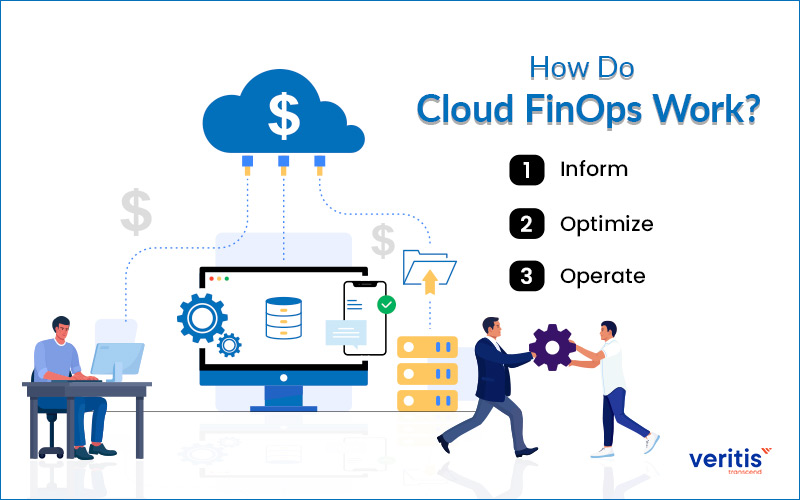
A cloud financial management software designed to maximize business value is called Cloud FinOps. It is a cultural practice that blends industry best practices with corporate culture to ensure financial responsibility to the cloud’s variable spending model. This operational framework combines business, finance, and technology to accelerate corporate value and promote financial accountability.
Cloud FinOps helps firms comprehend the intricacies and difficulties of cloud IT financial management. This procedure focuses on maximizing the benefits of cloud spending for your company. These might include using free credits, settling for less, using the cheapest services, projecting costs, and more.
Cloud FinOps assemble cross-functional teams to work together to reduce costs. These teams include management, DevOps, IT, and finance. A close-knit collaboration model is necessary to address cloud costs across the organization.
Consult our Cloud Consulting Expert
What is Cloud FinOps?
An organizational structure and cultural transformation that integrates technology, finance, and business to promote financial accountability and quicken the realization of company value through cloud transformation.
- FinOps empowers businesses to increase business value and enhance financial accountability.
- FinOps aids in comprehending the complexities of conventional IT financial management.
- FinOps aids in identifying the fundamental components and crucial performance indicators for achieving business value.
How Do Cloud FinOps Work?

The cost-management strategy used by Cloud FinOps is subtle. Three critical steps are involved in the FinOps lifecycle:
- Inform
- Optimize
- Operate
This lifecycle ensures that teams remain structured and concentrated on maintaining financial accountability and generating business value.
1) Inform
The Inform phase aims to inform the organization of every cloud cost. This is accomplished by providing total visibility and distributing cloud costs to relevant business units. Everyone’s financial understanding is the primary objective here.
Benchmarking is a component of this phase that involves internal objectives such as forecasts and budgets. It also demonstrates where the organization is and is not adding value to the business.
2) Optimize
Costs can be optimized once everyone is aware of the business objectives and value produced by the company. This phase entails offering the various teams actionable insights and suggestions.
During this phase, the company eliminates services that are unnecessary and drive-up costs. In addition, it automates resource rightsizing and improves resource utilization. These actions significantly reduce costs.
3) Operate
The last stage is to architect your cloud environment so that you can use it with the least amount of cloud resources. Finally, the organization develops governance guidelines and a structure to achieve its business, financial operations, and technological objectives. In this final phase, the primary goals are a measurable and ongoing improvement.
Useful link: What is Cloud Computing?
FinOps Principles

A non-profit industry organization called the FinOps Foundation outlines six guiding principles that serve as the foundation for FinOps. These guidelines are made to unite various business teams so they can participate in cloud-based activities:
1) Collaboration
To eliminate organizational silos, regular and transparent communication is essential. Costs are a different metric for cloud architecture that engineering, and operations staff must consider. The business and financial staff must simultaneously embrace the quick-paced and dynamic nature of IT. Teams must collaborate to create the procedures and standards for using cloud optimization.
2) Value
Decisions on the cloud strategy are based on business value for organizations. The cloud must be better than local workload deployments to justify its use. To analyze cloud costs, FinOps teams employ tools such as trending and variance analysis. They can evaluate cloud workloads and costs at the same time to get helpful information about how the business operates.
3) Reporting
FinOps depends on accurate and timely reporting to keep track of cloud spending. Additionally, it needs performance metrics that the FinOps team can use to assess the success of any cloud architecture deployment. Finally, reporting can help you make the most of your cloud spending by pointing out workloads that might be over or under-provisioned.
4) Ownership
Accountability is driven by ownership. Allow each product team to manage their cloud usage according to their available budget. Provide teams with the practices and tools to identify and comprehend all cloud costs, set cost and performance targets, and monitor progress over time. Missed goals should prompt a thorough investigation of cloud strategy usage.
5) Centralize Cost Reductions
FinOps requires teamwork, but a core team should spearhead the effort and oversee cost-benefit analysis. For instance, a central team should identify and oversee cloud cost benefits such as committed use discounts, reserved instances, and other volume or custom discounts from cloud providers. Engineering and operations teams can be relieved of this burden by a single team dedicated to negotiating discounts. Additionally, it can distribute costs to other teams and cost centers using cloud resources.
6) Teams Need to Coordinate
FinOps requires seamless team collaboration for it to be effective. For instance, the collaboration between the engineering, management, development, and finance departments is essential. The effectiveness and originality of both teams should be continually enhanced in concert with one another.
The specified goals are more easily accomplished when all the organization’s stakeholders work together towards a common goal. Teams produce more outstanding results because they have a shared understanding of the cloud expenses for the company. A unified view of the organization’s cloud spending helps teams produce better results. Working together and pursuing a common objective is thus one of the top priorities.
7) A Centralized Team Leads FinOps
Centralized teams decide together. Additionally, working from a central location makes it simpler to follow a common objective than when various teams work independently.
All departments must work together to ensure a successful FinOps practice. For instance, teams in finance and management can access roadmaps from development and engineering teams. Teams also improve communication and can create KPIs that apply to all teams.
8) Everybody Takes Responsibility for Their Cloud Usage
Accountability access is necessary for all teams using Cloud FinOp services. Each team should be aware of and accountable for its spending, as this prevents finger-pointing and allows various teams to collaborate on reaching predetermined objectives. Teams can also keep track of their goals to ensure accountability.
9) Decisions Influenced by Cloud Business Value
An entire organization’s success or failure can be determined by key decisions. FinOps-driven organizations should base their decisions on the cloud’s business value rather than its price. The business’s focus may change if cost is the only consideration. For instance, if increasing spending is required, a company is better able to increase the dependability of its services. A company shouldn’t, in theory, compromise in value and quality to cut costs.
Useful link: What are the Different Types of Cloud Computing Services?
Which Vendors are the Top Ones in FinOps?
Most companies offer cloud management services since FinOps tools focus on reducing cloud cost management. Go through the following list of the top vendors:
Data and Cloud Service Providers for FinOps
- Amazon Web Services EC2
- Microsoft Azure
- Google Cloud
- AliBaba Cloud
- Dell Cloud Manager
Management Services for Clouds
- Cloudyn
- Apptio
- BMC Software
- Commvault
- Skeddly
- Spreadsheets
- CPM Tools
- IBM Bluemix Open Whisk
- New Relic
FinOps Best Practices

FinOps initiatives can be approached in various ways. Still, they all share the same fundamental objective: to utilize cloud resources and services effectively and economically while providing the best value possible for the organization. The following FinOps best practices can assist a team in achieving this goal:
1) Create the FinOps Team You Need
When using a FinOps approach, this is by far the most crucial step. Some businesses refer to this group as a cloud center of excellence. However, some refer to it as the FinOps Team. For many, the group may have a vague title and consist of part-time, cross-functional team.
This group should serve as a governing body that develops KPIs and measurements to aid teams in understanding the company’s unit economics and offers best practices. This group should serve as a governing body that develops KPIs and measurements to aid teams in understanding the company’s unit economics and offers best practices.
Usually, this team has a direct route to executive leadership. However, depending on their involvement with cloud activities should include officials from engineering, technology, and finance.
For instance, your budget may be managed by a finance manager. A product owner who oversees all of the products and a cloud owner on the engineering tech side. This group will outline the procedures that act as boundaries for the entire company.
2) Increase Your Organization’s Cloud Visibility
The fact that teams whose actions contribute to cloud cost management need to understand cloud cost drivers presents a significant difficulty when operating in the cloud. Therefore, establishing cloud cost awareness for all parties involved in the cloud strategy is a crucial FinOps tool. Affected teams want visibility and a clear understanding of how their actions affect cloud expenses.
It’s important to remember that different organizations will have varying nuances or perspectives on cloud computing expenses. So, giving them cost information in a language they can understand is crucial.
3) Establish A Single Source of Truth
Create a single location where you always go to check your cloud finance charges. AWS Cost Explorer is typically the default tool when teams first begin using AWS. Unfortunately, this has limits, even though it’s a nice place to start. For instance, AWS Cost Explorer only offers a two-dimensional filtering system and doesn’t support multiple filters. It also takes work to understand the data it generates because it’s not the most accessible tool.
For managing cloud finance costs, larger businesses may use three to four tools. With various tools being used by each team. This poses a challenge because each team approaches cost from a different perspective. And the data lacks consistency or agreement.
4) Use Strategies for Cost Savings and Waste Reduction
When all three of the aforementioned items are in place, use reserved instances (RIs) and savings plans as low-hanging fruit for cloud cost optimization. Consider private pricing arrangements, depending on the services you use.
Then, consider waste-reduction strategies. For instance, get rid of any unused old resources. A storage bucket that costs USD 100 per month and hasn’t been used in four years costs USD 1,200 annually, or almost USD 5,000. However, this may seem like a small amount for a multi-million-dollar company. Such Applications are expensive to use in several instances.
5) To Better Understand Cloud Efficiency, Measure Unit Costs
Cloud optimization is meant to encourage innovation. Therefore, it’s unlikely that your engineering team should spend its time cutting costs to save money.
Useful link: What You Should Know About Containers Threats in Cloud Computing
Conclusion
The FinOps framework can completely change your company in all areas. It enhances the financial stability of your business and generates profit. But, of course, you should adopt the best practices available to accomplish this. FinOps is a new cloud operating model that enables the management of cloud costs, usage insights, data-driven decision-making, and genuine innovation.
It promotes collaboration between IT, engineering, finance, procurement, and the larger organization, changing IT from a cost center to a service provider that changes how businesses operate.
Veritis, the Stevie Award winner, will assist you in implementing this new method of operation to achieve the transparency, predictability, and governance required for efficient cloud financial operations. So, get in touch with us to have a comprehensive FinOps approach.
Explore Cloud Services Got Questions? Schedule A Call
Additional Resources:
- How Does Cloud Computing Help Fintech?
- The Biggest Clouds Myths that Every Organization Must Do Away With
- What is Cloud Migration? Strategy, Process, and Tools
- Global Cloud Market to Reach Nearly USD 800 Billion by 2028: Survey
- Cloud Security Automation: Best Practices, Strategy, and Benefits
- 9 Keys to Selecting a Right Cloud Managed Services Provider (MSP)
- Cloud Infrastructure Automation: The Imperative for Cloud Success!
- Hybrid Cloud Vs Multi Cloud: What’s the Difference!